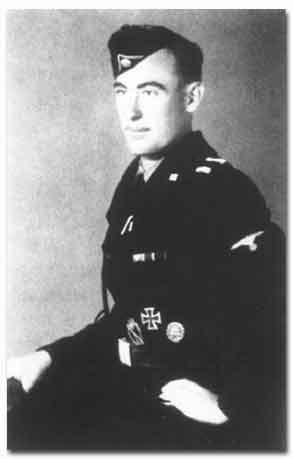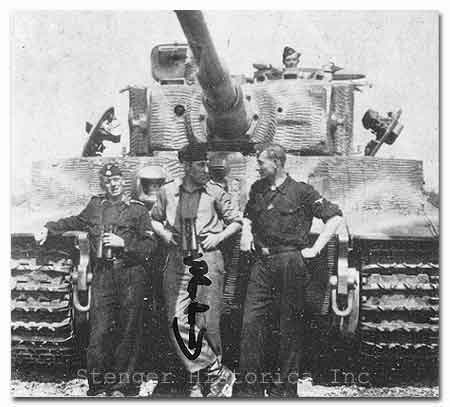
SS-Oberscharführer
Paul Eggers
I./s.SS-Pz.Abt.502 (102)
Träger
des Ritterkreuz des Eiserne Kreuze

In 1943, a so-called "Tiger" organization and working-staff (Arbeitsstab) was established that paralleled the tank replacement and school detachment 500, of Paderborn. The staff was responsible for organizing or replenishing Tiger detachments that had been withdrawn from action. At the onset, Major Otto led the staff at the training barracks at Mailly le Camp, France. Major Jürgens assumed command when the staff was transferred to the Training Barracks Wezep at Zwolle. The accomodations at Wezep had to be abandoned as a result of enemy activity whereby Maj Jürgens and his staff were transferred to the Training Barracks Ohrdurf in Thüringen. The organization of the heavy tank detachment 102 (s.Pz.Abt.102), as a SS-Pz.Abt. began in early 1944. Forty-five type Tiger I Ausf. E were transported on 8 trains between 21 April - 29 May 1944 to Wezep. A few groups were also established in Bordeaux, Argentan and Paderborn. During the initial phase of organization, the commander of the 102 was SS-Sturmbannführer Lackman. In Argentan, SS-Hauptsturmführer Fischer was in command. After a short but tough training phase, 14 brand new Tigers were transferred to the 2.Kompanie, commanded by SS-Hauptsturmführer Willy Endemann, on 6 June 1944, the day of the Allied invasion along the French Atlantic coast. On 13 June the s.SS-Pz.Abt.102 was loaded and transported to St. Pol south of Calais. After 2 days the Abteilung was entrained again and transported west of Paris. Here the Abteilung received orders on 2 July to proceed to the front. Eight Tigers, vehicle numbers 211, 212, 213, 214, 224, 231, 233 and 221 of the 2./Kompanie rolled from Paris towards the front. Consulted was Egon Kleine and Volkmar Kühn, Tiger: Die Geschichte einer legendären Waffe 1942-45, Motor Buch Verlag (Stuggart: 1987), pp. 196-198.
On 13 July, the Pz.Gren.Rgt.22, 10.SS-Pz.Division, reported a combat strength of only 400 men. In order to maintain its fighting capabilities, the division would have needed 1000 replacements every 10 days, of which 90% were needed for the grenadier regiments. In reality, only 120-150 men were acquired for both regiments from the field replacement battalions (Felderstaz-Bataillon). The Pz.Gren.Rgt.22 was forced to disband one of the 3 battalions due to the high number of loses of company, platoon, and group commanders.

Paul Egger (center) in France,
1944.
Copyright SHI
Before the reorganization could be completed, British troops launched a large-scale attack on 14 July against the sector of the 10.SS-Pz.Division. The main objective of the attack was Hill 112. A thick smoke screen and a heavy artillery barrage preceded the attack. While lacking a divisional reserve, the 10.SS-Pz.Div. successfully defended and repelled every attack with the support of artillery that, in a rare exception, had a large quantities of ammunition at its disposal.
In addition, the s.SS-Pz.Abt.102
assisted in reclaiming Hill 112. SS-Oscharf.Paul Egger, platoon commander in
the 1.Kompanie, took matters into his own hands and led a counterattack through
the thick smoke with 4 Tigers into the Allied flank. Egger's Tigers knocked
out 14 tanks and 7 anti-tank (AT) guns and, after pursuing the retreating Allies,
allowed German infantry to reclaim all the ground that had been lost.
Personally, Paul Egger knocked out 7 Allied tanks raising his career total to
sixty-eight. Other small Allied penetrations were also repelled after immediate
counterattacks. Despite the high number of casualties suffered on 15 July from
uninterrupted artillery and tank fire, the 10.SS-Pz.Div. remained in control
of Hill 112. For this action Paul Egger was decorated on 30 April 1945 with
the Knight's Cross, to the Iron Cross (Nr. 3465).
Click on map for a high-resolution reference-map.
Account based on official
award documentation for the Knight's Cross, provided to the author by Paul Egger
15 July 2001. Paul Egger was also decorated with the German Cross in Gold. Trained
as a Luftwaffe pilot, Egger flew 100 missions until he was shot down over the
English Channel. Due to sever head-wounds, he could not continue to fly.
Copyright Stenger Historica 2003